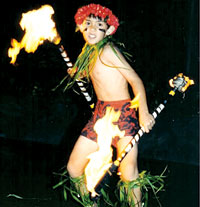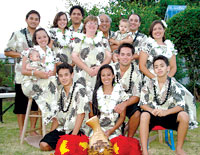The 15 members of Joe Ahuna’s family dance troupe are likely to thrill the thousands of local spectators who will watch them bravely reenact a Samoan knife dance, which practitioners refer to by the cuddly nickname of “Dance of Death.”

But for this group, the most important response comes from fellow performers.
Representing the United States at Folkmoot USA, the Waynesville-based international folk-dance festival, Ahuna Ohana isn’t as concerned as, say, Korea’s Jun Eun Ja Dance Company or Romania’s Somesul Napoca about earning the goodwill of the Americans in the stands. The Hawaiians already have home-team advantage. Instead, Joe Ahuna says, his group focuses on acting as ambassadors to the other dancers, many of who have never traveled in the United States.
“United States is good people,” Ahuna says. “We come in as an American family to eliminate bad feelings and stereotypes. Hopefully they’ll take that message home.”
Having spent much of his adult life promoting and participating in cultural exchange, Ahuna feels Folkmoot is one of the best venues in which to develop cross-cultural understandings. He and his son danced in the Waynesville-based festival in 2003.
“We all speak different languages, but music bridges the gap,” Ahuna explains. “Folkmoot is really effective in building friendships.”

When the Ahunas last came to Folkmoot, they shared the bill with a team of Polish dancers who performed a traditional ax-leaping number. One weapon-toting hoofer apparently can’t resist another: The team from Poland was keen to learn how to dance with knives, while Joe and his son had long been eyeing the Polish dancers’ long-handled axes.
“So we taught them some of our songs, and they taught us some of theirs,” Ahuna recalls. “In that informal exchange, we became friends.”
As a boy, Ahuna wasn’t as lucky as the Poles: He learned the wildly dangerous Samoan fire-knife dance without the benefit of professional instruction. Or any instruction at all.
While the fire-knife dance sounds like a deep-seated tribal tradition to haole ears, it’s actually a spanking new addition to the world’s dance repertoire—one that postdates the foxtrot and the Lindy hop. The dance is rooted in the Samoan ailao, a fierce pre-war ritual that culminated with the dancer twirling his war knife. But the fire, so familiar to the honeymooners and game-show-prize-package winners who feast on poi and whole hog at Hawaii’s hotel luaus, wasn’t added to the mix till 1946, when innovator Letuli Olo Misilagi was performing at a Shriners’ convention in San Francisco. As his tells the story in Flaming Sword of Samoa: The Story of Samoan Fire Knife Dance (Watermark, 2004), he was strolling through Golden State Park, an area popular with buskers, when he spotted a man eating fire and a girl juggling a light bulb-capped baton.
Misilagi wrote: “I stared at the fire eater, then the baton twirler. The baton twirler, then the fire eater. And just like that, I had an idea to add ‘sizzle’ to my knife dance.”
Misilagi wrapped the ends of his machete in towels, and borrowed fuel from the fire eater to set them aflame. Today’s fire-knife dancers still use a similar setup for their acrobatic performances.
“I use a sword with a blade about two-and-one-half inches wide, 25 inches long,” reveals Ahuna. He first saw the fire dance at a Boy Scout Jamboree in Idaho, where one of his troop members demonstrated his knife skills.
“When I came home, I asked my mom if she could buy me a Samoan fire knife,” says Ahuna.
And here’s where the uninitiated must demonstrate a little cross-cultural understanding: She said sure. In a society saturated with Samoan traditions, giving a 16-year-old a deadly blade didn’t strike anyone as strange.
“She really wasn’t concerned about it being dangerous,” Ahuna insists. “The concern was really if I was going to win money, or just put it in the closet.”
Ahuna read up on fire-knife dancing at the library, and figured he’d learned enough to enter his high school’s talent show.
“I wasn’t very good,” he says. “But I was gutsy.”
Ahuna presoaked his knife with gas, but, much to his distress, discovered it had evaporated when he came on stage to light it. He bolted offstage to pour more fuel on his blade, and then ran back, leaving a splattered trail of gas. When he ignited his knife, the entire school nearly went with it.
“I swore I’d never dance again,” says Ahuna.
But he started dancing again in college, joining a team that traveled around the world, sharing Polynesian traditions. When he and his wife had children, they were all made members of the fledgling family dance troupe. The Ahunas have since performed throughout the United States and Japan. While Ahuna admits many Americans view his fire-knife, hula- and hoop-dancing family as foreigners—“they don’t treat us as though we were from Mexico, but Hawaii isn’t South Dakota,” he points out—they’re proud to be the U.S. contingent at Folkmoot.
“We feel very blessed to be part of the United States. We’ll be showing the other teams that Americans are just like them: We enjoy life and sharing happiness with others.”
Folkmoot opens its 2007 season with a three-group performance at East Junior High School in Marion on Monday, July 16. The public Parade of Nations happens at 1 p.m. on Friday, July 20, (free) in downtown Waynesville. All groups will perform in Asheville at UNCA’s Lipinksy Auditorium on Saturday, July 21, at 7:30 p.m. and on Sunday, July 22, at 2 p.m. $20/reserved, $15/general admission, half-price for kids 12 and under. Folkmoot performs in Franklin, Clyde, Lake Junaluska, Maggie Valley, Cullowhee, Flat Rock and other WNC locations throughout the remainder of July. For a full schedule, visit www.folkmootusa.org



Before you comment
The comments section is here to provide a platform for civil dialogue on the issues we face together as a local community. Xpress is committed to offering this platform for all voices, but when the tone of the discussion gets nasty or strays off topic, we believe many people choose not to participate. Xpress editors are determined to moderate comments to ensure a constructive interchange is maintained. All comments judged not to be in keeping with the spirit of civil discourse will be removed and repeat violators will be banned. See here for our terms of service. Thank you for being part of this effort to promote respectful discussion.